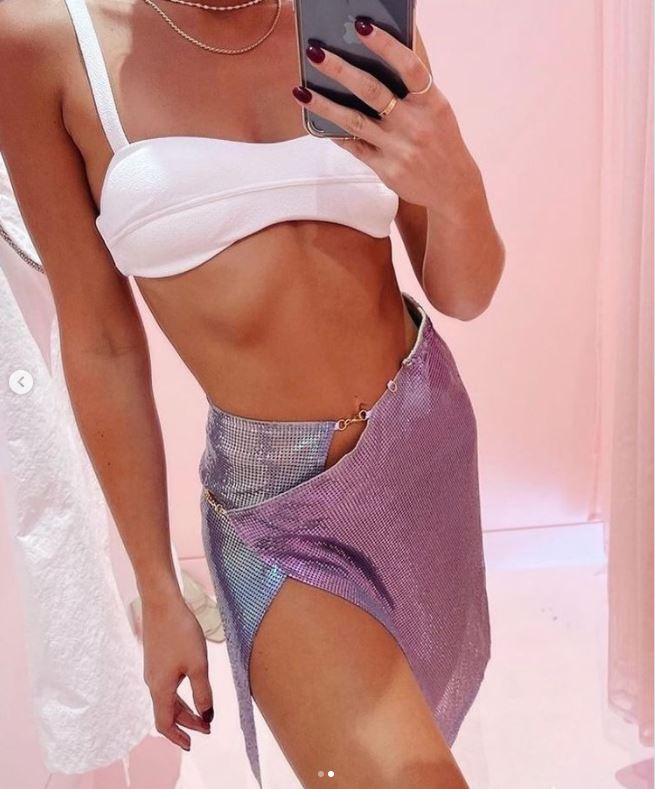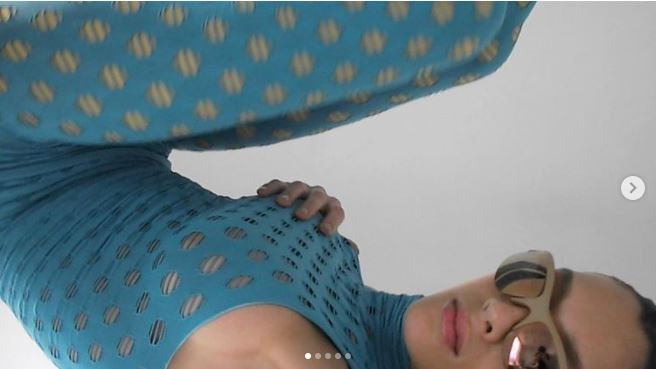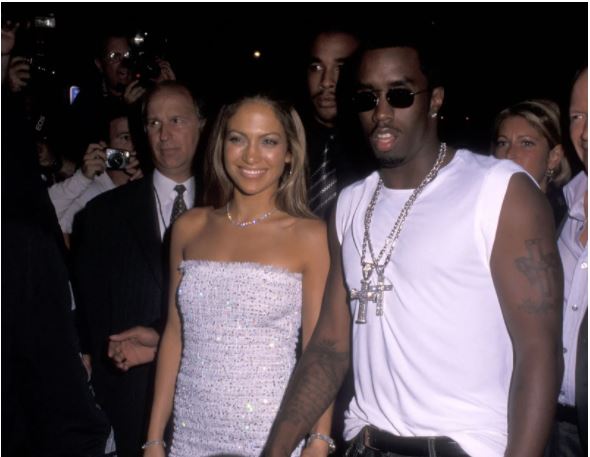The flashy components of an early aughts night-out outfit are instantly recognizable. In case you didn’t fully experience Y2K fashion in its prime (or are feeling nostalgic for it now), a trip down Hollywood memory lane lays it all out: Sex and the City cast mates attending a premiere in cami tanks and dresses; Destiny’s Child-era Beyoncé on the red carpet in sequined pants and a crystal-embellished silk top; tube tops making an appearance on… well, everyone. Then, there was Paris Hilton, hardly ever without a bare midriff, mini skirt, and some see-through element or form of bling.
When it comes to the ostentatious display of “going-out” fashion, no time period is without its key identifiers. Party attire can be likened to that of swing dresses in the ‘60s, flared pants of the ‘70s (glitz and sequins optional), ‘80s statement shoulders in amped-up color, and the spaghetti-strapped slip dresses of the ‘90s. Meanwhile, thanks to Hervé Léger, bodycon bandage dresses ruled the late 2000s and the earlier half of the 2010s.
Today, as spending sprees and social invites simultaneously make a return, statement-making going-out clothing does the same. Anyone paying attention, however, can’t help but notice the stark similarities to fashion’s past, namely the ‘00s, ‘90s, and ‘70s. Though, fashion historian Sara Idacavage, who is currently conducting doctoral research at the University of Georgia, says today’s party dressing may be more closely linked with the zeitgeist rather than the garments themselves.

 @poster__girl__official/Instagram
@poster__girl__official/Instagram
“I think the tendency for people to look back [on these decades] is linked to a sense of nostalgia for ‘simpler times,’” Idacavage tells NYLON. “Even if they were just as complicated and messy as the times that we’re currently living in.” She expects styles will show up differently than they did years ago, too. “A trend that seems to have reemerged is actually quite different than when it was popular in the past, even if the form is the same,” adds Idacavage. “This is because the context in which the trend is presented is entirely different, whether it be how it’s marketed, what it’s worn with, or why it’s worn.”
Online shopping searches reveal a pretty clear idea of what’s to come in going-out fashion as the vaccinated population grows and people eagerly return to socializing. According to digital fashion marketplace ShopStyle, which boasts 14,000 brands and 2 million site searches per month, one thing is for certain: the going-out top as we know it is back. Tube tops (50 percent), crop tops (36 percent), and corsets (33 percent) all saw an increase in searches from last year.
Similarly, while the onset of matching sets and suiting welcomes pants as an unexpected going-out staple, Patricia Maeda, womenswear director at global trend forecasting agency Fashion Snoops, says to expect a boom in mini silhouettes, as well. “Historically, rising hemlines have always signaled optimism and liberation,” she tells NYLON. ShopStyle’s site has also seen an increase in searches for both bodycon dress and mini skirt this year, up 27 and 11 percent, respectively. All signs point to a budding aesthetic reminiscent of what can be thought of as the golden age of partying, which was so thoroughly documented by celebrity paparazzi, pre-Instagram. Today, going-out fashion’s new wave indubitably comes with a fresh set of young designers — think LaQuan Smith, Farai London, KNWLS, and more — leading the way and taking over our feeds.

@poster__girl__official/Instagram
London brand Poster Girl, for instance, specializes in all things mini and body hugging. Thanks to celebrity fans including Doja Cat, Dua Lipa and Kylie Jenner, Poster Girl’s innovative shapewear dresses prove to be a night-out go-to on the rise. “Dressing up has become its own culture, and as such, there is so much thought that goes into a ‘look’ nowadays,” co-founders Natasha Somerville and Francesca Capper tell NYLON in an email. “Each [of our dresses are] designed intricately to be a ‘look’ in itself.” Pulling references from the ‘90s and early aughts, most dresses from the brand come complete with heart-shaped crystal buttons and a swirl-print mesh cut-out, truly without the need for further accessorizing, as the designers suggest.
New York City’s Kim Shui merges cut-out silhouettes, which consumers “can’t get enough of” right now, according to Lauren Yerkes, chief merchandising officer at Revolve, with sheer fabrics, another propelling element of today’s going-out aesthetic. Skin-baring styles continuing to trend as COVID-related restrictions lift makes sense to Maeda, noting that sensual fashion has become a protest of our confinement. Designer Shui, who self-describes her designs as “sexy, going-out styles,” tells NYLON that her brand unexpectedly saw an increase in sales during the pandemic, a detail that seems to lend to the idea that nighttime fashion was bound to prevail and adapt to the given climate.
The brand’s most popular styles are telling: A mesh halter dress featuring a paisley print and a mega cut-out front and center, as well as an ultra-sheer, multi-tie tank and mini-skirt set. “I believe [the influx] stemmed from this desire to still feel good and feel like you’re out and about,” Shui says. “It makes girls feel bold and confident.”

@kimshuistudio/Instagram
Silhouettes and textiles aren’t the only telltale signs of an outfit ready for a night on the town. In the form of just about any style you can imagine, the fashion collective has officially put a halt to minimalism, in favor of more colorful prints. As far as specific motifs, it seems that anything goes, but you can expect to notice a few favorites. ShopStyle notes the search for butterfly prints saw a 50-percent increase over the last year, while the majority of today’s “It” brands have had a hand in the current psychedelic print takeover.
In a league of its own where experimental motifs are concerned, it feels safe to say Maisie Wilen proves influential in the new wave. A former designer for Kanye West’s Yeezy, Los Angeles-based Maisie Schloss and her tech-inspired prints entered the fashion scene largely by way of the Kardashian-Jenner clan in 2019 before taking over Instagram and beyond. “Going-out clothes are for sure a huge element of what we offer,” Schloss tells NYLON. “I want to make things that feel very special in that if the customer has it, it’s their favorite thing.”

@maisie_wilen/Instagram
While one of Schloss’ most-loved designs, the Orbit City Dress, is the ultimate garment for a lover of print, the brand’s perforated turtleneck and matching leggings have quickly become a catalyst for the eye-catching matching sets trend in the luxury sector. Surprisingly, Schloss says she designed the garments with the idea of wearing them separately and layered with other pieces in mind. “Customers have definitely made matching sets a part of the brand, even though I didn’t necessarily imagine that from the beginning,” she says.
As quickly as the trend cycle seems to move with the inspiration-overload nature of social media — Idacavage even highlights geographic location, subcultural affiliations, and certain societal norms as factors behind rapidly fluctuating trends — fashion during the early 2020s seems to echo, if only faintly, late fashion theorist James Laver’s 20-year-rule, wherein we see trends from two decades prior reemerge. Perhaps we do have the pandemic to thank for a return to sensuality, extravagance, and outright sartorial fun. In any case, here’s to the girls with Mariah Carey’s 2000-era crystal-encrusted butterfly top on their summer mood boards. It’s your time to shine — quite literally.
Originally posted from “NYLON” by Jamila Stewart




No Comments